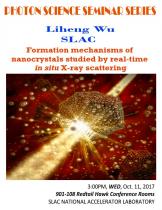Speaker: Liheng Wu, SLAC
Program Description:
The fine control of monodisperse nanocrystals (NCs) over their size, shape, and structure is of great importance for understanding their properties. In the past two decades, significant developments have been achieved in colloidal synthesis of NCs. However, synthesizing NCs in a predictive way is still challenging due to a lack of mechanistic understanding of their formation. In this talk, in situ monitoring of high-temperature (up to 300 oC) synthesis of NCs in non-polar solvents (e.g., 1-octadecene) using synchrotron-based X-ray scattering is discussed. We chose the syntheses of single-metallic Pd and bimetallic PtSn NCs as two examples. We found that different surface ligands dramatically changed the nucleation kinetics of Pd NCs, leading to well-tuned particle sizes by simply changing the ligands for the synthesis. Taking advantage of simultaneous small and wide angle X-ray scattering, we observed the unique formation of bimetallic PtSn NCs through sequential doping of Sn inside pre-formed Pt NCs. The in situ probing provides the basis for designing better synthetic strategies and accelerating the chemical synthesis of various functional NCs. Moreover, the real-time X-ray characterization techniques enable the unprecedented discovery of crystallization of nanocrystals into three-dimensional superlattices in solution at high temperatures, providing new opportunities to create diverse superlattices with desired structures and functionalities.





